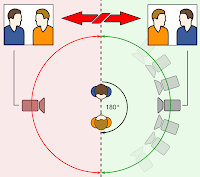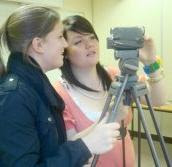-Darkness: This makes the audience feel that something is being hidden from them. It sometimes makes a scene more realistic/believeable and therefore more intense. Darkness in a scene provides a cover for any crimes that are being committed. The use of lighting in thriller films creates the shadows which will leave the audience making guessing about what is going to happen next.
-Creepy: Suspense is created throughout the film. There are various ways in which this is achieved (darkness being the most obvious way). As tension builds up, the pace of the film gathers leading up to the conclusion. The audience is manipulated by the director to feel certain ways at different points in a film. The intention of a thriller is to build up tension for the audience for the conclusion, whilst still scaring them at the same time. This is sometimes achieved by the use of quick cuts.
-Close Ups: Not being able to see a lot of what is going on behind the characters makes the audience feel more connected to them and their story, as they are not distracted by what is going on in the background. Also, it could imply that there aren't any weapons involved and that there are more psychological elements to the film. It also gives the audience the chance to see the characters emothions and subtle reactions to the events in the film.
-Objective Point of View: Another common shot in thriller films is the objective point of view. This is when the audience can see what the character cant. Essentially, we are in a much better position than the character. The audience will feel a connection to the character as they empathise with them and want them to survive over the villain or source of evil.
-Theme: A common theme in thriller films is a crime being committed and/or investigated. In most cases, the crime/s are down to a serial killer. Thriller films typically follow the efforts of a detective trying to piece together the evidence of a crime that has been committed. However, whilst this is going on, the serial killer will be planning his/her next crime.
-Sound: The use of sound is critical in thriller films, as it creates an atmosphere and tone to the film. The use of string instruments e.g. violins, assists in creating a tense atmosphere. As the pace of the film gathers the frequency of the music does as well. It builds up throughout the film as the plot develops. When there is a crucial event in the film, the strings will build up to indicate to the audience that something is happening. The event will be marked by the cresendo of the music. Sometimes to create even more tension, the music will be built up and there will be a sort of anti-climax, so that the audience are expecting something to happen.
-Red Herring/Twist: Thrillers are well known for evoking thought within the audience. When watching thrillers, people will be considering what the character is - or should be - doing, and how they, themselves, would react in the situations portrayed in the film. Thrillers are a lot less predictable than other genres like romantic comedies, and people watching them are constantly left guessing. An important factor in making the film unpredictable and effective at the same time is a red herring/twist. The audience are lead to believe certain things as the film progresses, but as the story unfolds, certain things are revealed about a character or the story that completely changes the audiences perception.





